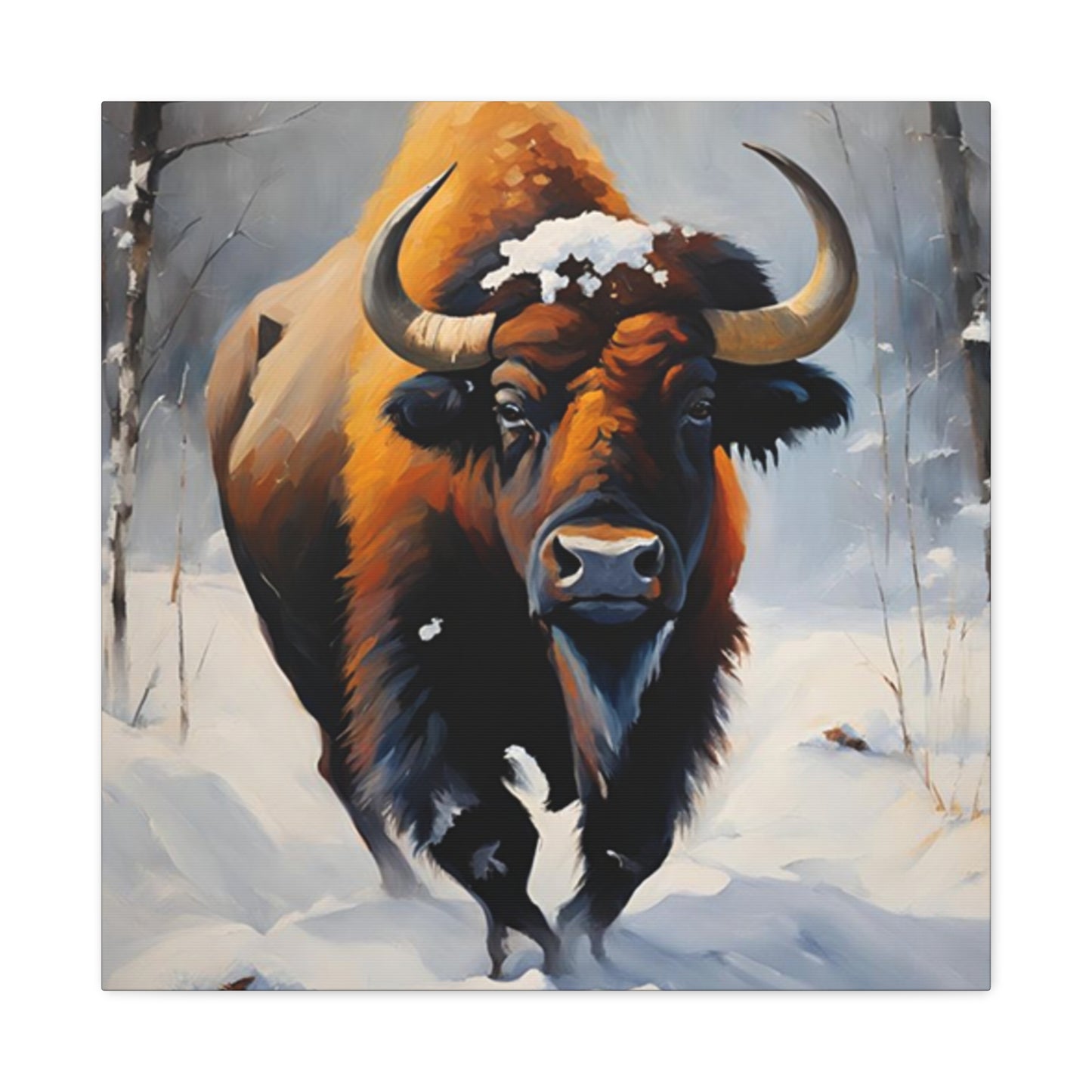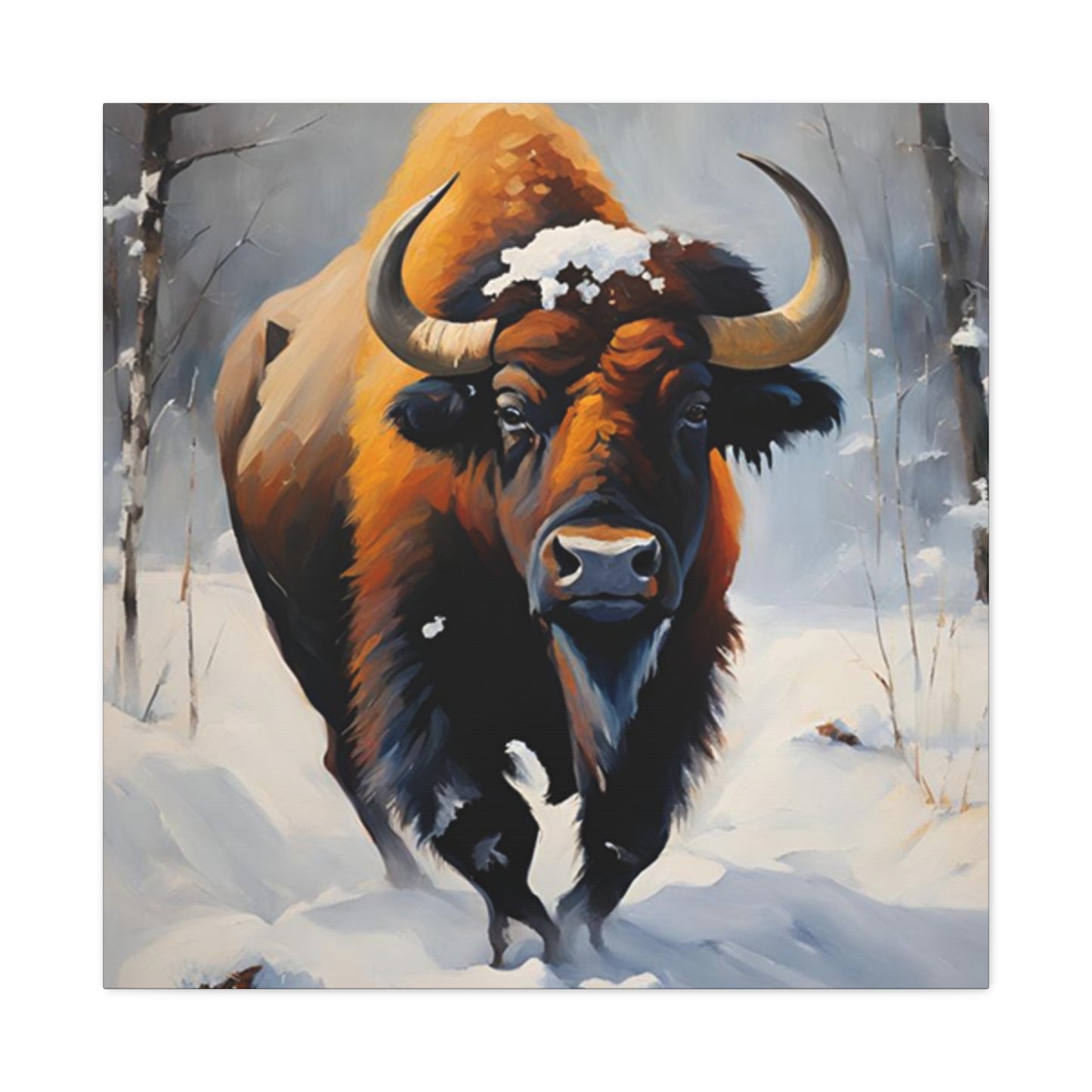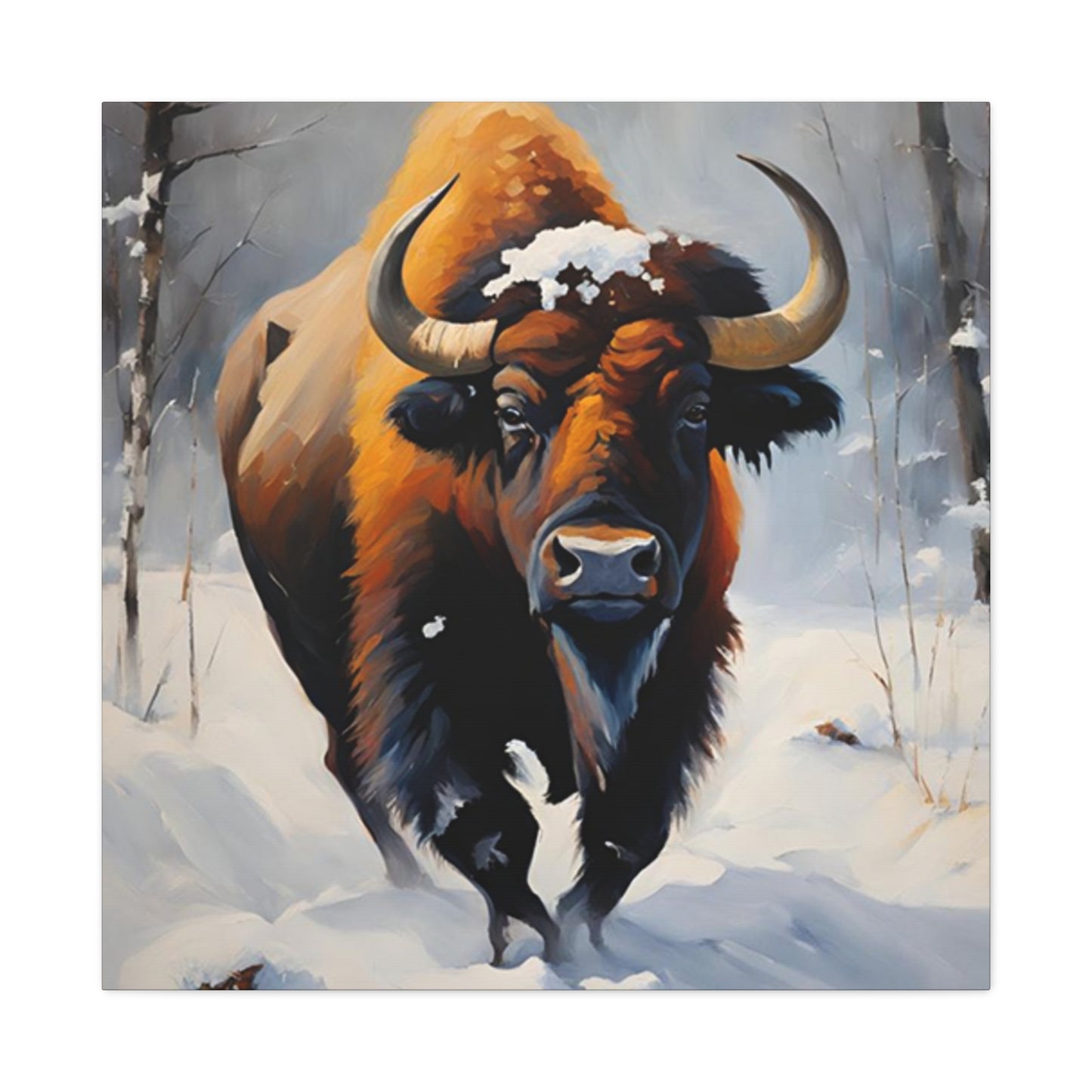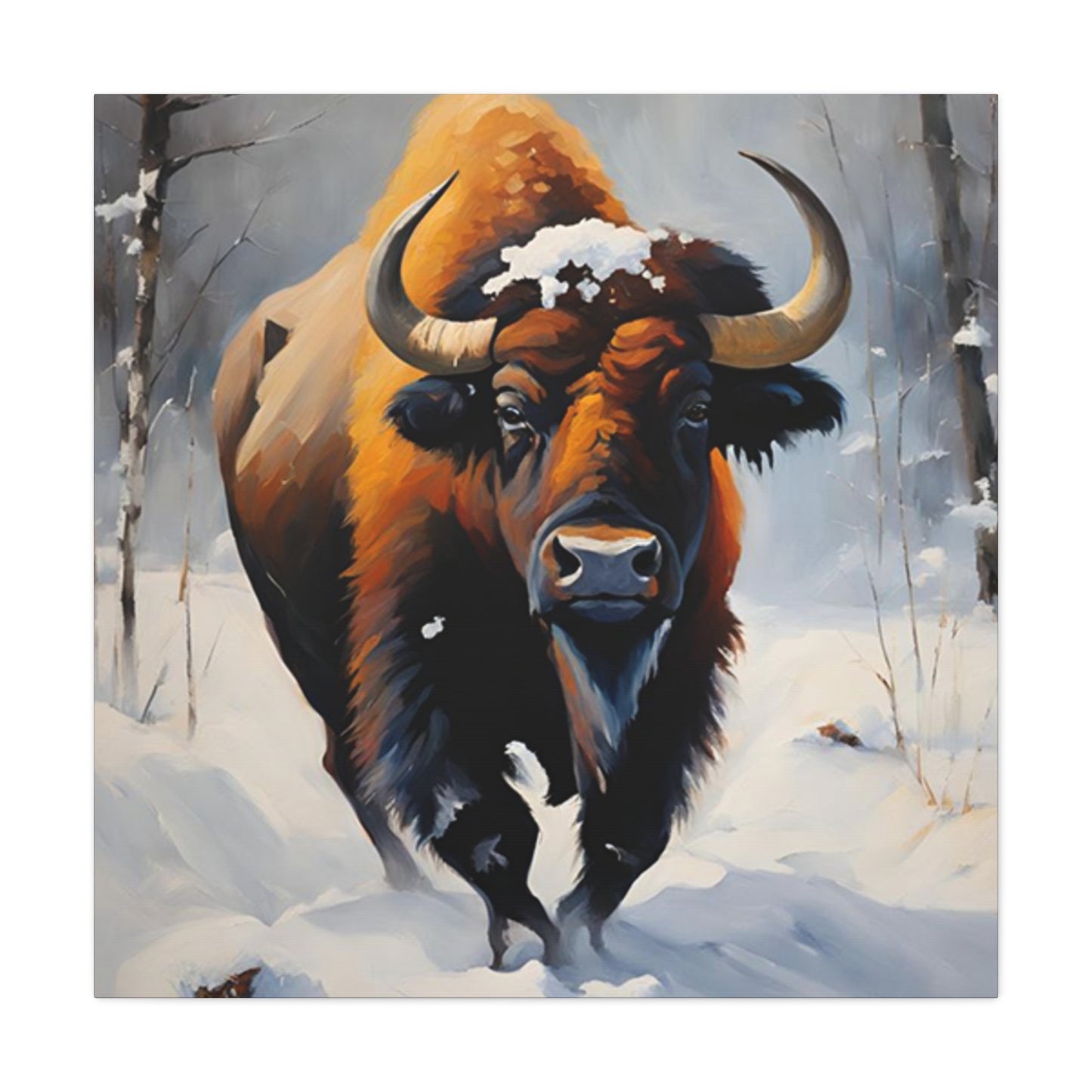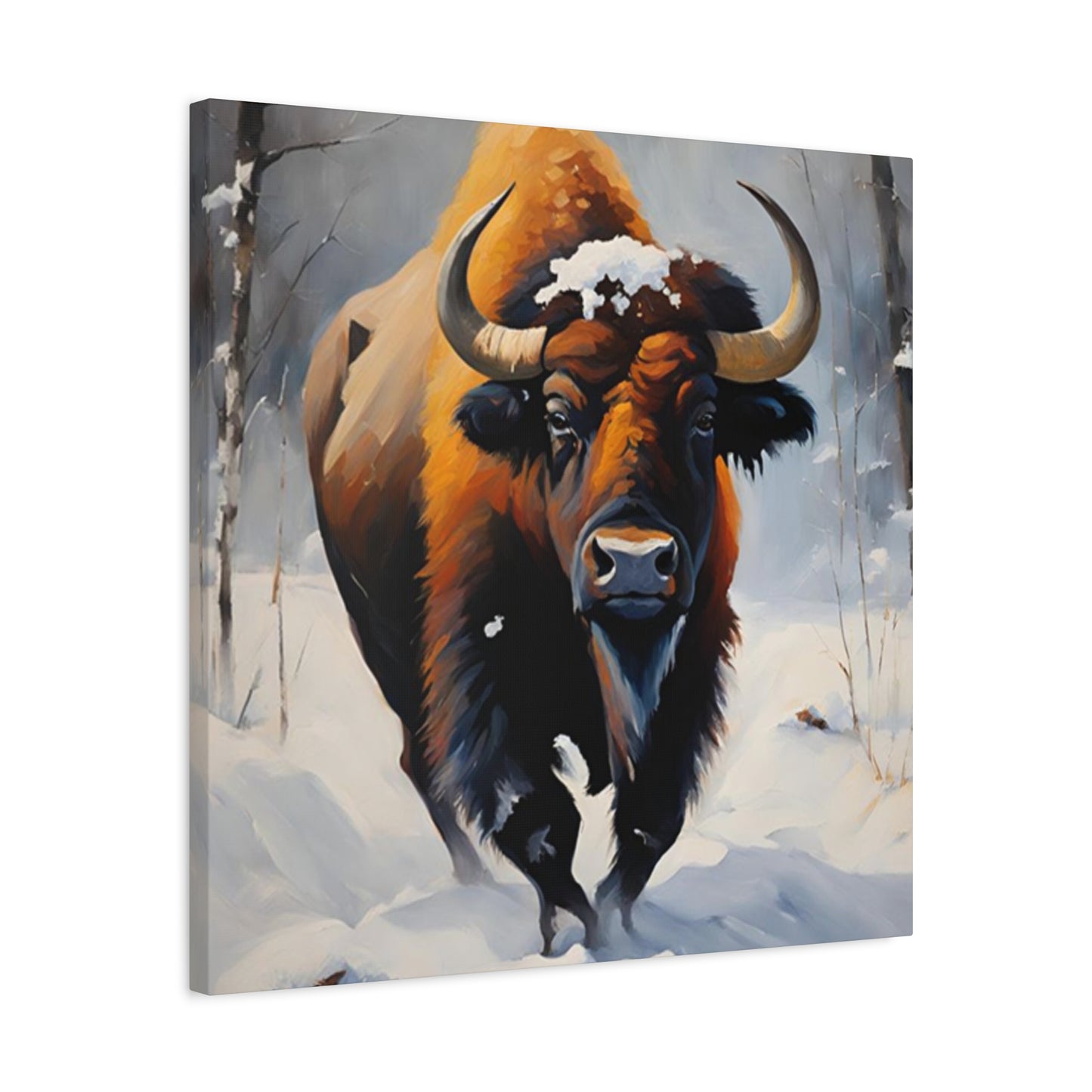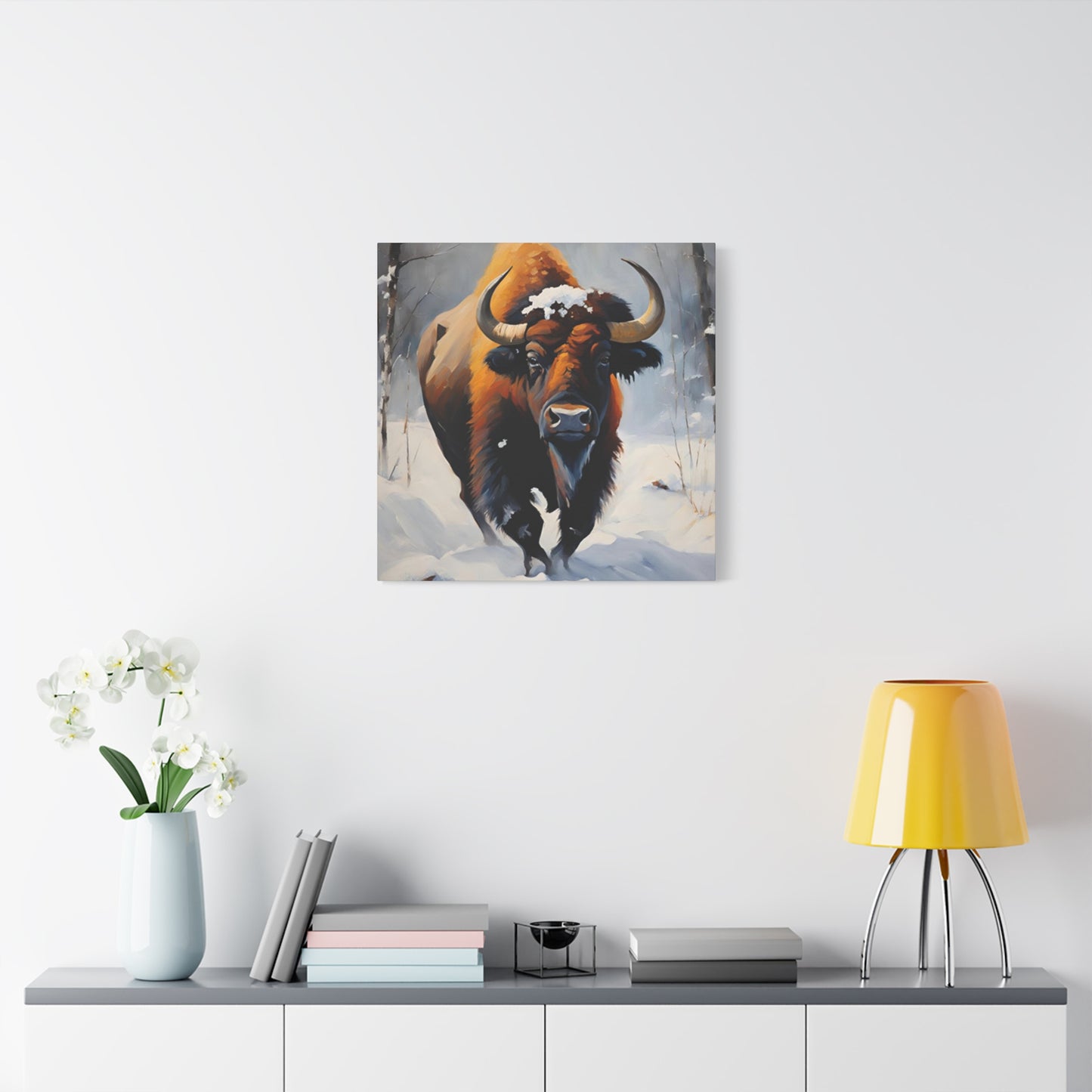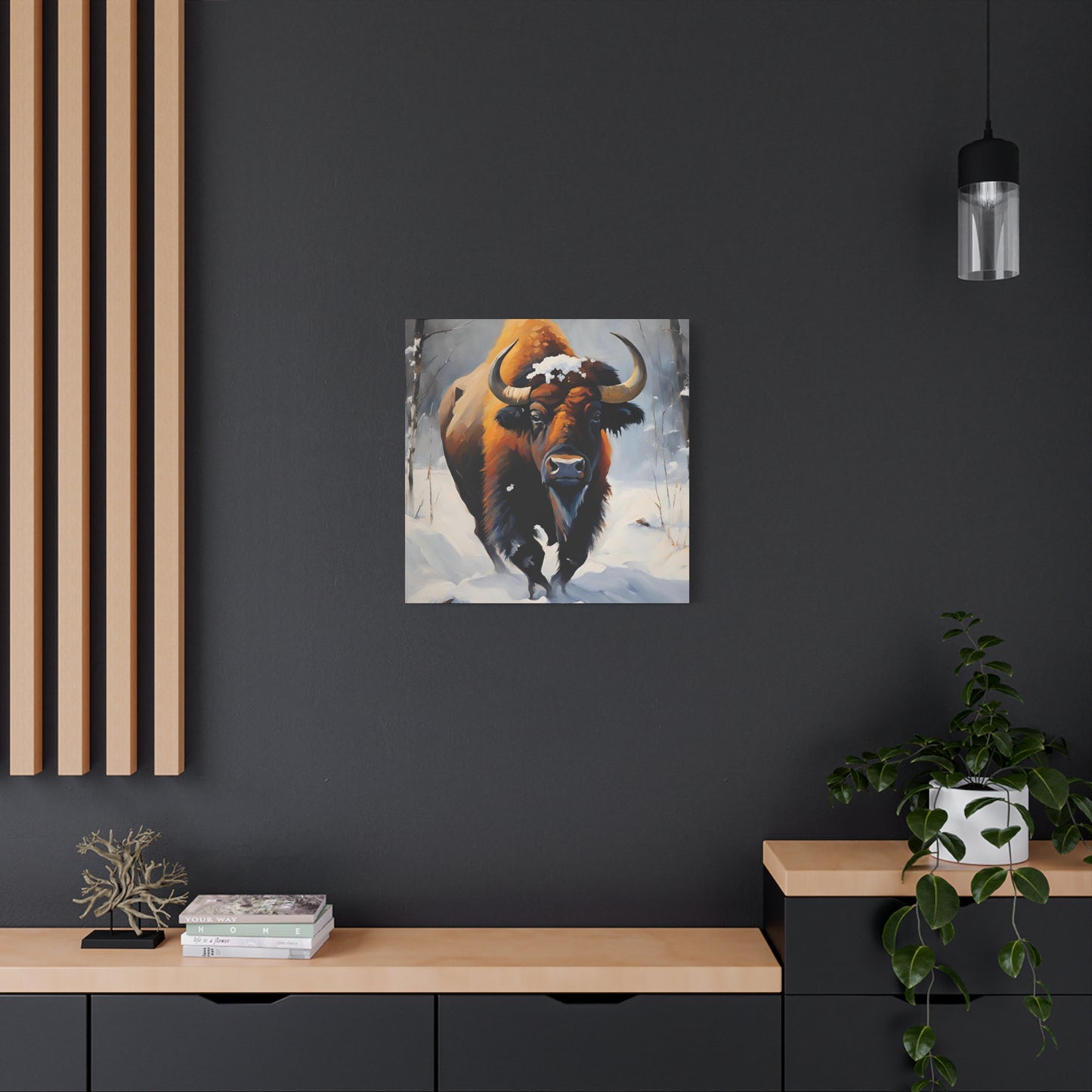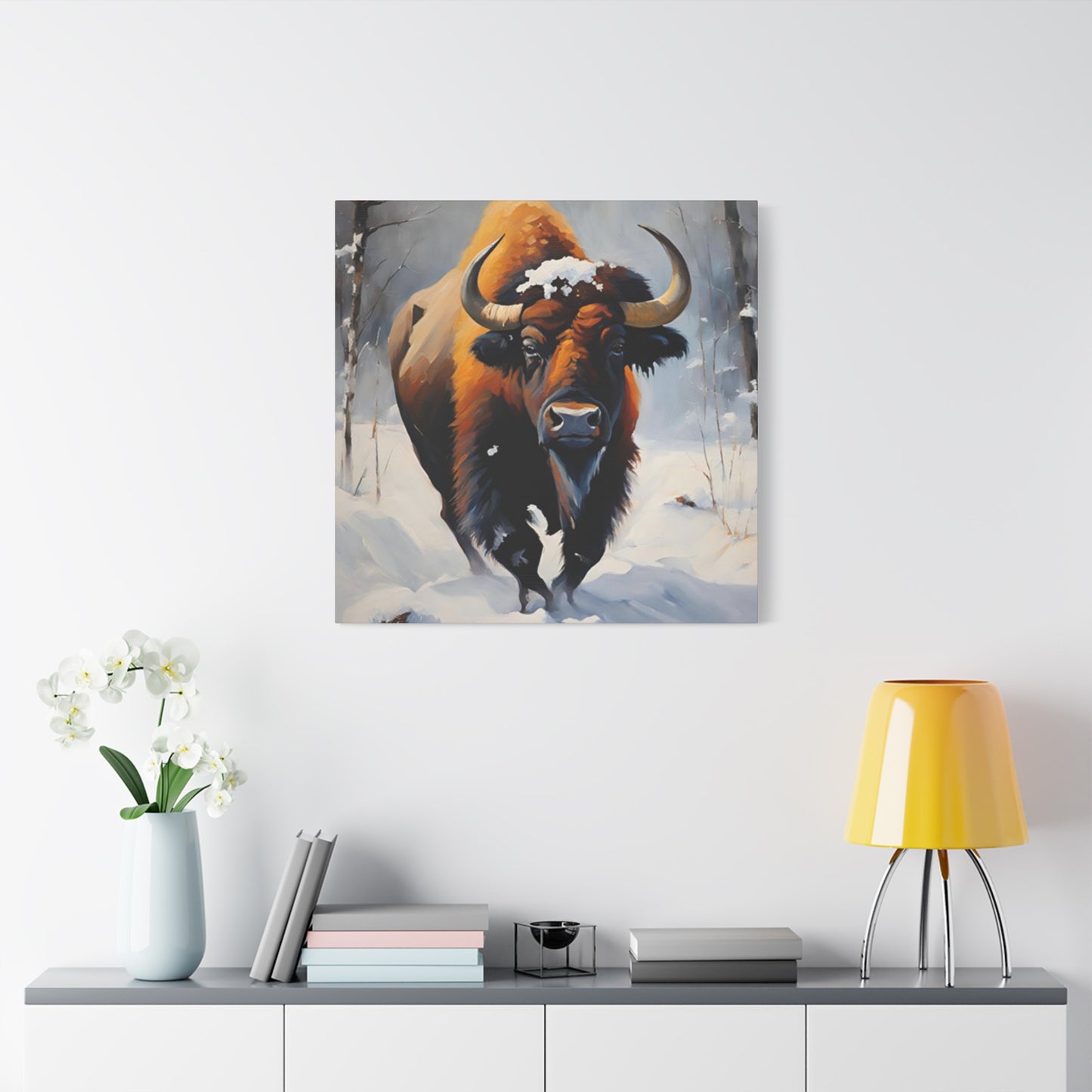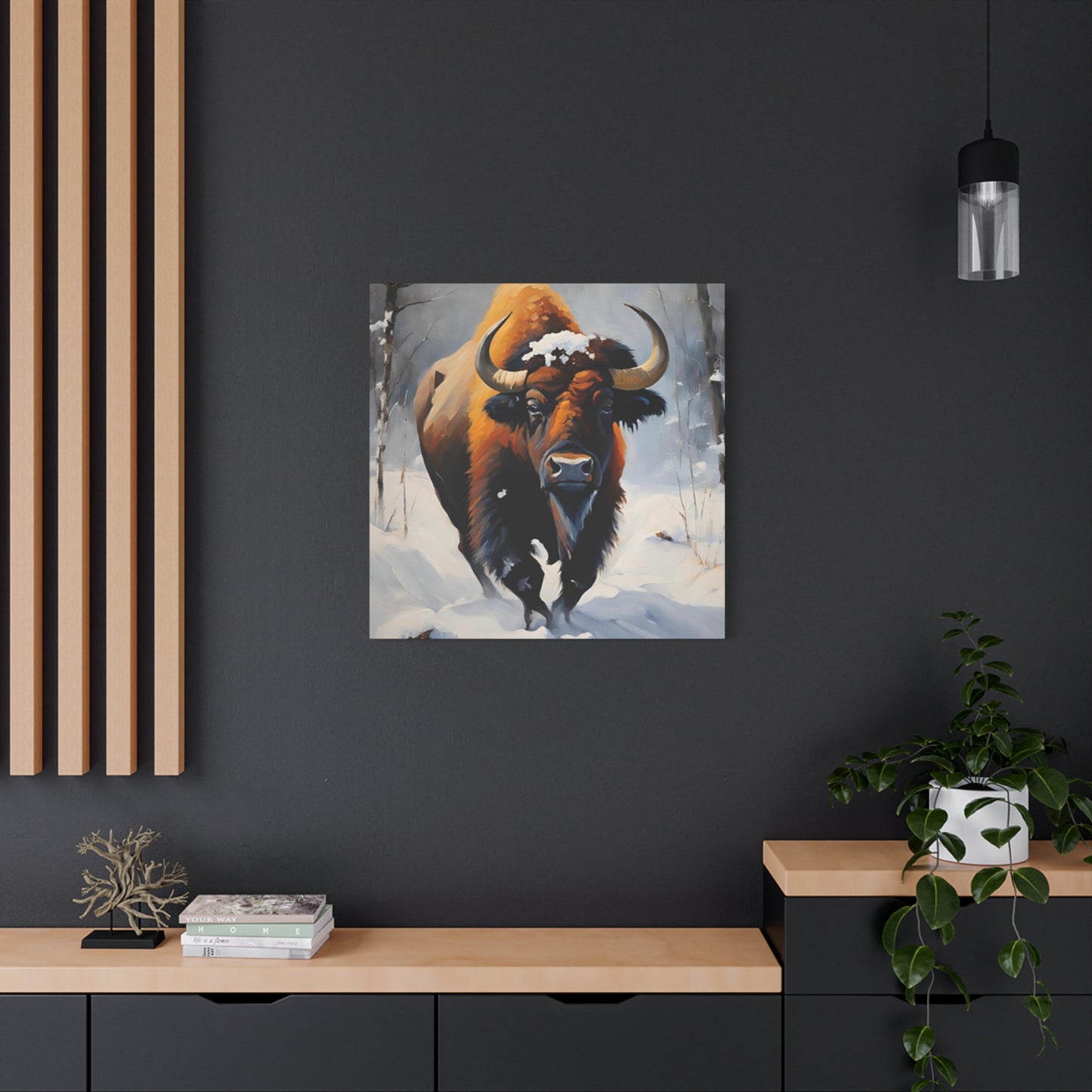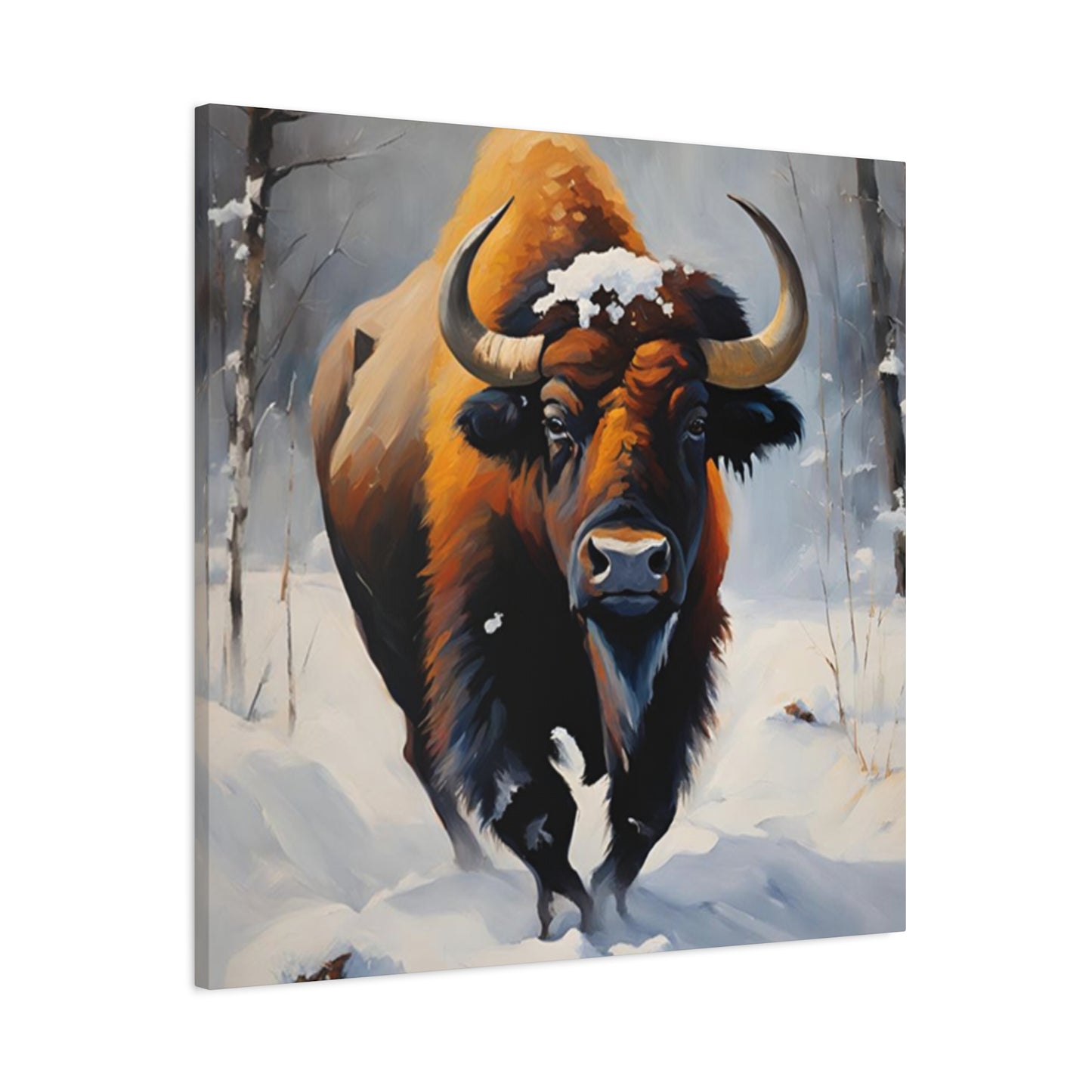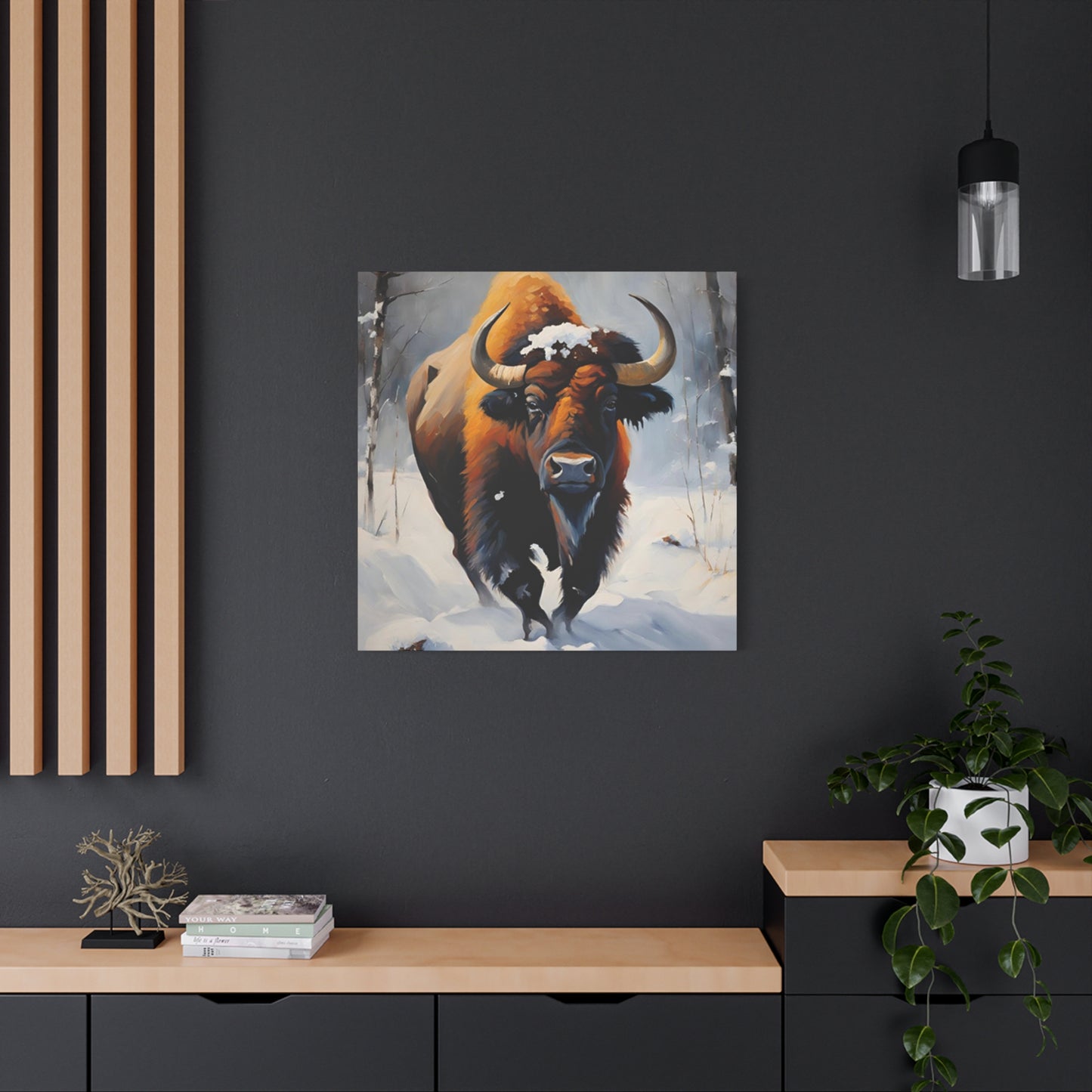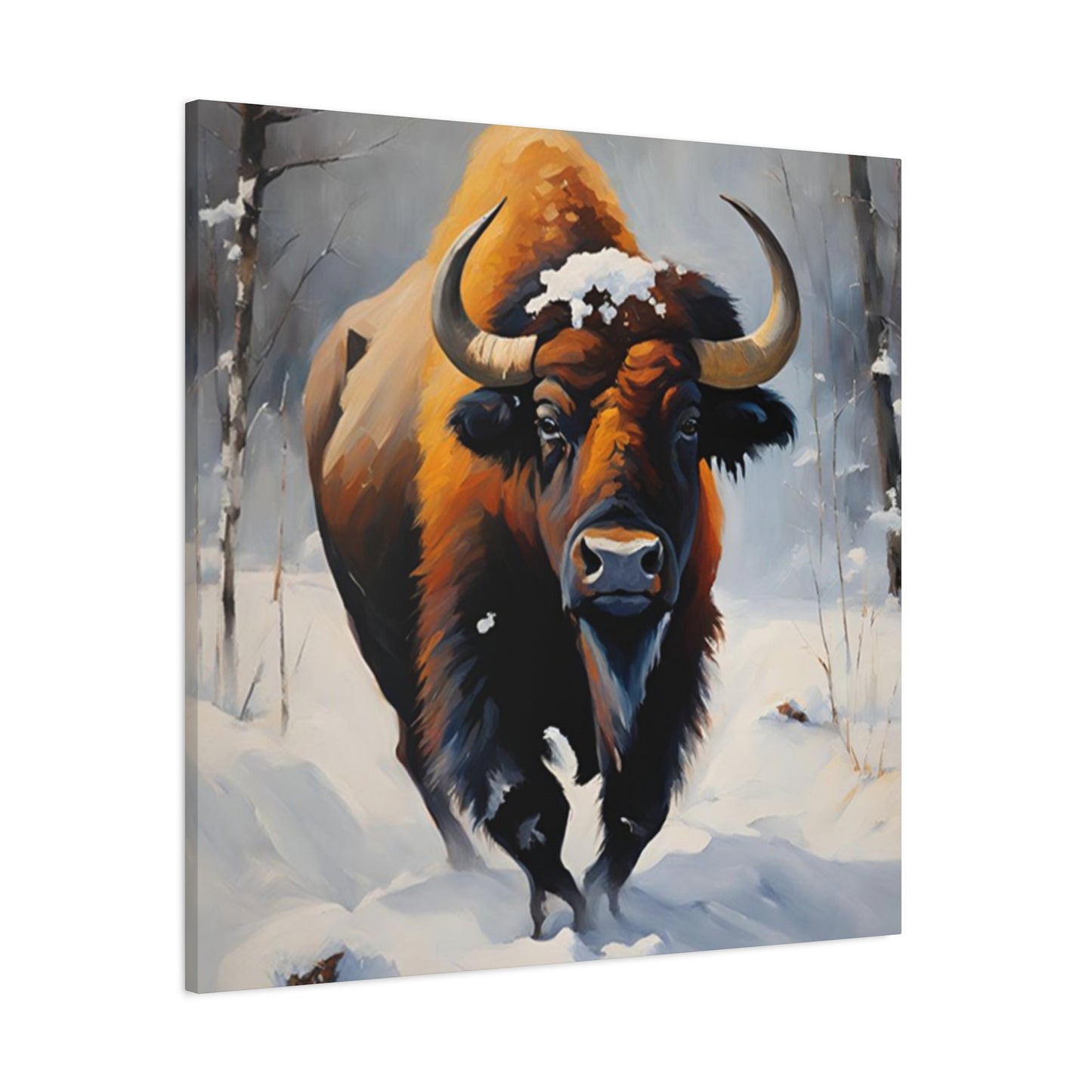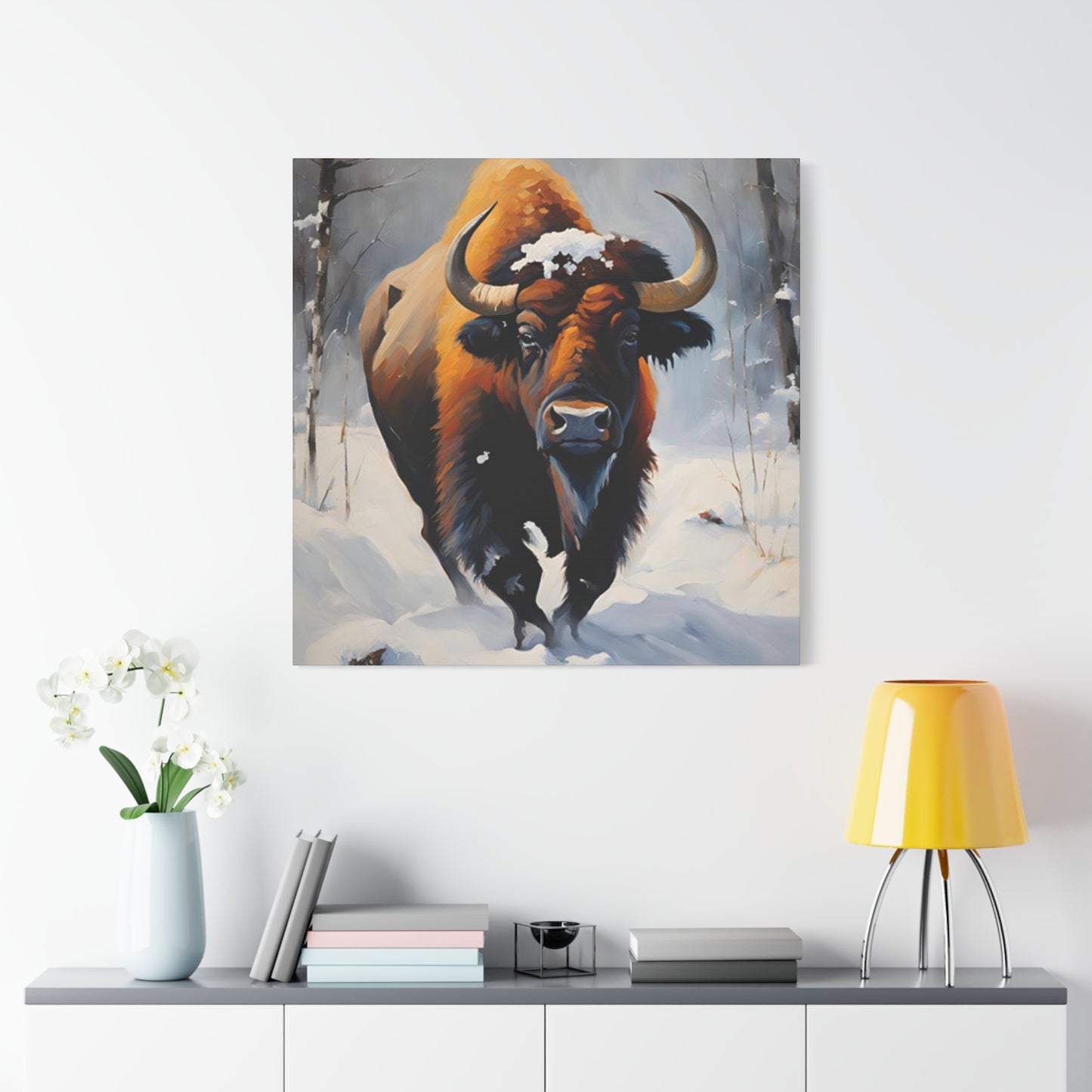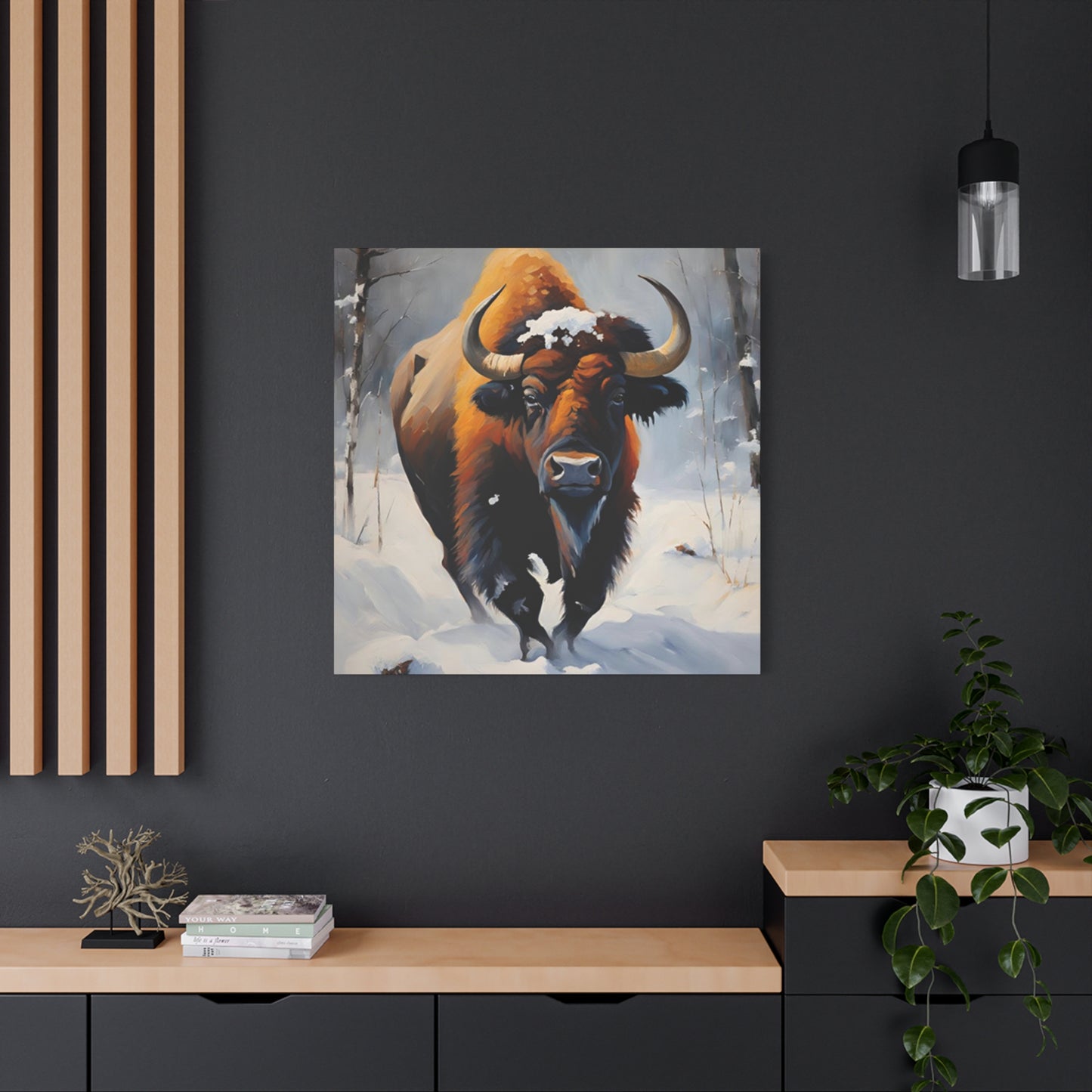Bull in Snow Wall Art: Capturing Winter Wildlife Majesty in Home Decoration
Winter landscapes possess an extraordinary ability to transform ordinary scenes into breathtaking masterpieces, and when combined with the powerful presence of bulls, they create compelling visual narratives that resonate deeply with viewers. The art of depicting bulls in snowy environments has gained tremendous popularity among collectors and enthusiasts who appreciate both wildlife artistry and seasonal beauty. These magnificent creatures, with their imposing stature and dignified bearing, become even more striking when portrayed against pristine white backdrops of freshly fallen snow.
The fascination with bull imagery in winter settings stems from the remarkable contrast between the animal's raw power and the serene tranquility of snow-covered landscapes. This juxtaposition creates a visual tension that captivates observers and invites contemplation about nature's dualities. Artists have long recognized the symbolic potential of combining these elements, using them to explore themes of resilience, endurance, and the harmonious coexistence of strength and serenity.
Contemporary art markets have witnessed a surge in demand for winter wildlife themes, with bull paintings and prints leading this trend. The appeal extends beyond mere aesthetic appreciation, touching on deeper psychological connections that humans maintain with both the natural world and seasonal cycles. Collectors often report feeling drawn to these pieces because they evoke memories of rural experiences, childhood winters, or simply represent an idealized connection to untamed nature.
The artistic interpretation of bulls in snowy environments requires considerable skill and understanding of both animal anatomy and meteorological effects. Artists must capture not only the physical characteristics of these powerful animals but also convey the atmospheric conditions that make winter scenes so compelling. The interplay of light reflecting off snow surfaces, the subtle shadows cast by overcast skies, and the way cold air seems to crystallize around warm breath all contribute to the overall impact of these compositions.
Professional artists specializing in this genre often spend extensive time studying bull behavior in winter conditions, understanding how these animals adapt to cold weather and how their movements change in snow-deep environments. This research translates into more authentic and emotionally resonant artwork that speaks to viewers on multiple levels. The resulting pieces often showcase bulls with thick winter coats, visible breath clouds, and postures that convey both alertness and comfort in harsh conditions.
The market for bull in snow artwork spans multiple demographics, from rural homeowners seeking to celebrate agricultural heritage to urban dwellers longing for connections to pastoral life. This broad appeal has encouraged artists to explore various styles and interpretations, ensuring that options exist for diverse taste preferences and decorating schemes. Whether rendered in photorealistic detail or interpreted through abstract expressionism, these subjects maintain their fundamental appeal across different artistic approaches.
Museum collections and private galleries have increasingly featured exhibitions focusing on winter wildlife art, with bull subjects often serving as centerpiece attractions. These shows demonstrate the sophisticated artistic techniques required to successfully capture both the majesty of these animals and the ephemeral beauty of winter weather conditions. Visitors frequently comment on the emotional impact of viewing large-scale bull paintings set in snowy landscapes, describing feelings of awe and peaceful contemplation.
The therapeutic aspects of winter wildlife art cannot be overlooked, as many individuals find genuine comfort in contemplating scenes that combine natural power with seasonal beauty. Psychological studies have indicated that viewing art depicting serene winter scenes can reduce stress levels and promote feelings of tranquility, while animal imagery often evokes protective and nurturing responses. The combination creates artwork that serves both decorative and wellness functions in residential and commercial environments.
Blending Natural Elements with Animal Power in Winter Artwork
The artistic challenge of combining natural winter elements with the commanding presence of bulls requires masterful understanding of both environmental conditions and animal characteristics. Snow, as an artistic medium, presents unique opportunities for creating dramatic visual effects through its interaction with light, shadow, and color. When artists successfully integrate these elements with bull subjects, the resulting compositions demonstrate the profound beauty that emerges when nature's opposing forces converge harmoniously.
Professional artists working in this genre typically begin their creative process by studying the specific ways snow affects visibility, texture, and atmospheric perspective in outdoor environments. Fresh powder snow creates entirely different visual effects compared to wet, heavy snow or the crystalline surfaces of ice-crusted drifts. Each variation requires different artistic techniques to capture authentically, from the subtle gradations needed for fresh snowfall to the sharp contrasts created by windblown accumulations.
The physical properties of snow offer artists numerous opportunities for creative interpretation. Light snow can create misty, ethereal atmospheres that soften the hard edges of bull anatomy, while heavy snowfall might obscure portions of the animal, creating mysterious and intriguing compositions. Some artists specialize in capturing the moment when snow is actively falling, using various brush techniques or digital methods to convey the movement and density of precipitation.
Bull anatomy presents its own set of artistic challenges that become more complex in winter settings. The animals' thick winter coats alter their apparent size and shape, while cold weather affects their posture and movement patterns. Successful winter bull art requires accurate understanding of how these physical changes appear visually, ensuring that the finished artwork maintains biological authenticity while achieving desired aesthetic goals.
Color theory plays a crucial role in creating compelling bull and snow combinations. While snow appears white to casual observation, experienced artists understand that it actually reflects countless subtle color variations depending on lighting conditions, time of day, and atmospheric factors. These color relationships must be carefully balanced with the earth tones typically associated with bull coloring to create harmonious yet dynamic compositions.
The emotional resonance of these combined elements extends beyond mere visual appeal. Bulls traditionally symbolize strength, determination, and protective power, while snow often represents purity, tranquility, and natural beauty. When skillfully combined in artwork, these symbolic associations create layered meaning that speaks to viewers on both conscious and subconscious levels, explaining the enduring popularity of this artistic theme.
Contemporary artists have developed innovative approaches to depicting the interaction between bull subjects and snowy environments. Some focus on the contrast between warm animal breath visible in cold air and the surrounding frozen landscape. Others explore the way snow accumulates on the animals themselves, creating natural sculptural effects that enhance the three-dimensional quality of painted or printed artwork.
Digital art technologies have expanded the possibilities for creating sophisticated bull and snow compositions. Artists can now manipulate lighting effects, atmospheric conditions, and textural elements with precision that would be difficult or impossible to achieve through traditional media alone. However, the most successful digital artists still rely on solid understanding of traditional artistic principles to ensure their work maintains emotional authenticity and visual credibility.
The seasonal nature of snow adds temporal significance to these artistic subjects. Viewers often associate winter imagery with specific memories, holidays, or life experiences, creating personal connections that extend beyond aesthetic appreciation. This temporal dimension helps explain why bull in snow artwork often becomes treasured family pieces that gain sentimental value over time, passed down through generations as both artistic objects and memory anchors.
Environmental awareness has also influenced contemporary interpretations of winter wildlife art. Many artists now use their bull and snow compositions to subtly comment on climate change, habitat preservation, or the importance of maintaining wild spaces where such encounters between animals and winter weather can continue to occur naturally. These deeper thematic layers add intellectual substance to pieces that might otherwise be appreciated purely for their visual qualities.
Optimal Placement Strategies for Winter Bull Artwork
The successful display of bull in snow artwork requires careful consideration of environmental factors, viewing angles, and complementary design elements that enhance rather than compete with the dramatic subjects. Living rooms represent the most popular location for these pieces, where their impressive scale and emotional impact can be fully appreciated by both residents and guests. The key to effective living room placement lies in selecting wall locations that receive appropriate lighting while avoiding areas where glare or shadows might diminish the artwork's visual impact.
Natural lighting considerations become particularly important when displaying winter-themed artwork, as the interplay between actual daylight and depicted snow creates dynamic viewing experiences that change throughout the day. North-facing walls often provide the most consistent lighting conditions for artwork display, avoiding the harsh directional light that can wash out subtle color variations in snow-covered landscapes. However, some collectors prefer east or west-facing locations where changing light conditions create evolving relationships between the artwork and its environment.
Hallways and corridors offer unique opportunities for displaying bull in snow pieces, particularly those with horizontal orientations that complement the linear nature of these areas. The sequential viewing experience created by walking past these artworks allows observers to notice details that might be missed in static viewing situations. However, hallway placement requires careful attention to viewing distances and lighting conditions to ensure the artwork remains visible and impactful from multiple approach angles.
Bedroom environments can benefit from the calming qualities associated with winter landscapes, though the dramatic presence of bull subjects may be too stimulating for some individuals seeking restful atmospheres. When choosing bull in snow artwork for sleeping areas, many collectors opt for pieces that emphasize the serene qualities of winter scenes rather than the more dynamic aspects of animal behavior. Softer color palettes and gentler compositions often work better in these intimate environments.
Home offices and studies provide excellent settings for winter wildlife art, where the themes of strength and perseverance associated with bull imagery can serve as sources of motivation and inspiration. The contemplative nature of snowy landscapes also complements work environments that benefit from occasional visual breaks and mental refreshment. Placement should consider computer screen glare and ensure that the artwork doesn't create visual distractions during focused work periods.
Dining room display requires consideration of how the artwork will interact with meal experiences and social gatherings. Bull in snow pieces can create excellent conversation starters while maintaining appropriate atmospheric qualities for dining. However, very large or dramatically intense pieces might overwhelm intimate dinner settings, making moderately sized works often more suitable for these areas.
Kitchen placement, while less common for valuable artwork, can work well for certain types of bull in snow pieces, particularly those with rustic or farmhouse aesthetic qualities. However, environmental factors such as cooking humidity, temperature variations, and potential exposure to grease or steam must be carefully considered to protect the artwork from damage.
Entryways and foyers offer opportunities to make strong first impressions with striking bull in snow artwork. These areas typically accommodate larger pieces that might overwhelm smaller rooms, and the dramatic impact of winter wildlife themes can create memorable experiences for visitors. However, entryway placement requires attention to traffic flow patterns and protection from potential damage caused by weather exposure when doors are opened.
Commercial environments such as offices, hotels, and restaurants have increasingly incorporated bull in snow artwork to create distinctive atmospheric qualities. These settings often accommodate larger scale pieces and can benefit from the professional, sophisticated appearance that high-quality winter wildlife art provides. Commercial placement requires additional consideration of durability, security, and maintenance requirements.
Gallery walls featuring multiple related pieces allow collectors to create comprehensive winter wildlife displays that tell more complete stories than single artwork installations. When creating gallery walls with bull in snow themes, successful arrangements typically vary size, orientation, and specific subject matter while maintaining cohesive color schemes and artistic styles. The spacing between pieces should allow each work to be appreciated individually while contributing to the overall compositional effect.
Psychological and Emotional Resonance of Winter Bull Art
The psychological impact of winter bull paintings extends far beyond mere visual appreciation, tapping into deep-seated human responses to both powerful animal imagery and seasonal environmental cues. Research in environmental psychology has demonstrated that exposure to winter landscape imagery can trigger specific neurological responses associated with calm contemplation and stress reduction. When combined with the protective, strength-oriented symbolism traditionally associated with bull imagery, these artworks create complex emotional experiences that many viewers find both soothing and empowering.
Seasonal Affective Disorder research has revealed interesting connections between winter imagery and mood regulation. Contrary to what might be expected, many individuals find that contemplating winter scenes, particularly those featuring strong animal subjects, can actually help alleviate some symptoms associated with seasonal mood changes. The combination of white snow reflecting light and the robust presence of bull subjects appears to create psychological associations with endurance, resilience, and the promise of renewal that follows winter seasons.
Color psychology plays a significant role in the emotional impact of these artworks. The dominant white and gray tones of winter scenes typically promote feelings of clarity and mental cleansing, while the warmer earth tones of bull coloring provide psychological grounding and stability. This color combination creates balanced emotional responses that many viewers describe as simultaneously calming and energizing, explaining why these pieces often become focal points for meditation or quiet reflection.
Cultural associations with both bulls and winter contribute additional layers of emotional meaning. In many cultural traditions, bulls represent fertility, abundance, and protective power, while winter symbolizes periods of rest, reflection, and preparation for future growth. Artwork combining these themes can evoke subconscious connections to agricultural cycles, family traditions, and ancestral relationships with the natural world that many modern individuals find missing from contemporary life.
The therapeutic applications of winter wildlife art have gained attention from healthcare professionals working in environments where stress reduction and emotional comfort are priorities. Hospitals, rehabilitation centers, and mental health facilities have reported positive responses from patients and staff when bull in snow artwork is incorporated into their environmental design. The combination of natural beauty and animal strength appears to provide psychological anchor points that help individuals cope with challenging circumstances.
Memory and nostalgia play important roles in how viewers respond to winter bull imagery. Many individuals report that these artworks trigger specific childhood memories of winter activities, family gatherings, or rural experiences that hold positive emotional significance. These memory connections create personal relationships with the artwork that extend beyond aesthetic appreciation, transforming decorative pieces into meaningful personal totems.
The concept of biophilia suggests that humans possess an innate attraction to natural elements and living things. Bull in snow artwork satisfies both aspects of biophilic attraction by combining animal subjects with natural environmental scenes. This dual appeal may explain why many viewers report feeling instantly drawn to these pieces, even when they cannot articulate specific reasons for their attraction.
Stress response research has indicated that viewing images of powerful animals in natural settings can trigger beneficial physiological changes including reduced cortisol levels and decreased heart rate variability. The specific combination of strength imagery with peaceful winter scenes appears to optimize these beneficial effects, creating artwork that functions as both decorative element and wellness tool.
Gender responses to bull in snow imagery often vary in interesting ways, with some research suggesting that male viewers may be more drawn to the strength and power aspects while female viewers often respond more strongly to the nurturing and protective qualities. However, these generalizations have many exceptions, and successful bull in snow artwork typically appeals across demographic boundaries by incorporating elements that speak to universal human experiences.
The mindfulness movement has embraced winter wildlife art as supportive elements for meditation and contemplative practices. The visual complexity of snow textures combined with the focused presence of bull subjects provides ideal focal points for mindful observation, allowing practitioners to engage in present-moment awareness while enjoying aesthetic beauty. Many meditation practitioners report that these images help anchor their attention during practice sessions.
Dimensions and Scale Considerations for Bull Snow Canvas Prints
The size selection for bull in snow canvas prints significantly influences both their visual impact and their integration into specific room environments. Large-scale prints, typically measuring 36 inches or greater in any dimension, create immersive experiences that can transform entire rooms and establish dominant focal points. These substantial pieces work particularly well in areas with high ceilings and generous wall areas, where their impressive scale can be fully appreciated without overwhelming the surrounding environment.
Large format bull in snow prints offer unique advantages for viewers seeking maximum emotional impact from their artwork. The increased scale allows for greater detail appreciation, enabling observers to study snow textures, animal fur patterns, and atmospheric effects that might be lost in smaller reproductions. Additionally, larger prints create stronger presence and can effectively anchor room design schemes around their dramatic winter wildlife themes.
However, large prints also present specific placement challenges that must be carefully considered. Viewing distance becomes critical with oversized pieces, as artwork that appears perfectly scaled from across a room may overwhelm viewers at close range. Living rooms and great rooms typically provide ideal environments for large bull in snow prints, offering sufficient space for appropriate viewing distances while allowing the artwork to serve as architectural features.
Medium-sized prints, generally ranging from 16 to 36 inches in largest dimension, offer versatility that makes them suitable for a wider range of environments and design applications. These moderately scaled pieces provide sufficient presence to command attention while remaining appropriately proportioned for most residential areas. Medium prints work particularly well in bedroom environments, home offices, and dining areas where intimate viewing experiences are desired.
The flexibility of medium-sized bull in snow prints extends to grouping possibilities, as multiple pieces can be combined to create gallery walls or thematic displays without individual pieces becoming lost in the composition. This size range also accommodates most standard framing options, making professional presentation more accessible and affordable for collectors working within budget constraints.
Small bull in snow prints, typically measuring 16 inches or less in largest dimension, serve specific functions that larger pieces cannot fulfill. These compact artworks excel in areas where wall space is limited or where subtle accents are preferred over dominant statements. Small prints work effectively in hallways, bathrooms, breakfast nooks, and other areas where gentle artistic presence is desired rather than dramatic impact.
The intimate scale of small prints allows for different types of viewer engagement, encouraging close examination of artistic details and techniques. Many collectors appreciate having small bull in snow pieces in areas where they spend quiet moments, such as reading nooks or morning coffee areas, where the artwork can be contemplated during peaceful daily routines.
Proportional relationships between artwork size and room dimensions require careful consideration to achieve balanced visual environments. Interior designers typically recommend that artwork should occupy approximately two-thirds to three-quarters of available wall space to create appropriate visual weight. However, these guidelines must be adapted based on ceiling height, furniture placement, and the presence of other decorative elements.
Ceiling height significantly influences optimal artwork scaling, as higher ceilings can accommodate proportionally larger pieces without creating overwhelming effects. Conversely, lower ceilings may require more modest sizing to prevent artwork from dominating the vertical aspects of room environments. The horizontal versus vertical orientation of bull in snow prints also affects how ceiling height impacts overall visual balance.
Multiple print installations allow collectors to combine different sizes effectively, creating dynamic displays that tell more complete visual stories than single pieces alone. Successful multi-print arrangements often feature one dominant large piece supported by smaller complementary works, or several medium-sized pieces arranged in balanced compositions that create unified yet varied visual experiences.
Custom sizing options available from many print providers enable collectors to achieve precise dimensional requirements for specific installation locations. This flexibility allows for optimization of both visual impact and practical considerations such as furniture placement, architectural features, and lighting conditions. Custom sizing particularly benefits collectors with unique wall dimensions or specific design requirements that standard sizes cannot accommodate.
Artistic Techniques for Depicting Snow Textures in Bull Art
The successful rendering of snow textures in bull artwork requires mastery of multiple artistic techniques that capture both the physical properties of frozen precipitation and its interaction with light, shadow, and atmospheric conditions. Traditional painting approaches often employ layering methods that build snow effects gradually, starting with base colors that establish overall luminosity and adding successive layers that create depth, texture, and realistic surface variations.
Dry brush techniques prove particularly effective for creating the crystalline sparkle often associated with fresh snow surfaces. By using brushes with minimal paint loading, artists can achieve the subtle texture variations that make snow appear authentic rather than flat or artificial. This technique requires considerable practice to master, as the amount of paint, brush pressure, and stroke direction all influence the final textural effects.
Palette knife applications allow artists to create more dramatic snow textures, particularly for depicting accumulated drifts or wind-blown formations. The knife edge can create sharp, clean lines that suggest wind-carved snow edges, while the flat surface enables smooth gradations for areas where snow appears undisturbed. Combining palette knife work with traditional brush techniques often produces the most convincing snow effects.
Glazing methods enable artists to achieve the translucent qualities that characterize real snow, particularly in areas where underlying surfaces show through thin snow coverage. Multiple thin glazes can create depth effects that suggest snow accumulation patterns while maintaining transparency that allows underlying textures to remain partially visible. This technique proves essential when depicting snow that has settled on bull fur or other textured surfaces.
Color mixing for realistic snow representation extends far beyond simple white paint applications. Experienced artists understand that snow reflects surrounding colors from sky, nearby objects, and atmospheric conditions. Shadow areas in snow may appear blue, purple, or gray depending on lighting conditions, while sunlit areas might show warm yellow or pink reflections from atmospheric filtering.
Digital art techniques offer expanded possibilities for creating sophisticated snow textures that would be challenging or impossible with traditional media. Layer blending modes, particle systems, and procedural texture generation can produce highly realistic snow effects with precise control over density, distribution, and interaction with other compositional elements. However, digital techniques still require solid understanding of how snow behaves visually in natural environments.
Atmospheric perspective becomes particularly important when depicting bulls in extensive snowy landscapes. Distant snow formations must appear lighter and less distinct than foreground elements, while maintaining sufficient detail to suggest the continuation of winter conditions beyond the immediate compositional area. Achieving proper atmospheric perspective requires careful control of value, color saturation, and edge quality throughout the composition.
Texture contrast between snow and bull subjects requires thoughtful handling to ensure that both elements read clearly while maintaining visual harmony. The smooth, reflective qualities of snow surfaces contrast dramatically with the textured, light-absorbing characteristics of animal fur, creating opportunities for dynamic visual effects. However, these contrasts must be balanced to prevent either element from overwhelming the other.
Seasonal lighting effects significantly influence snow texture appearance and must be accurately represented to maintain environmental authenticity. Winter light tends to be cooler and more directional than summer illumination, creating sharper shadows and more dramatic value contrasts. Overcast conditions produce different snow textures than bright sunshine, requiring artists to understand and accurately depict these variations.
Mixed media approaches combine various materials and techniques to achieve complex snow textures that single methods cannot produce alone. Some artists incorporate actual textural materials such as sand, salt, or specialized texture mediums to create physical surface variations that enhance visual texture effects. These approaches require careful planning to ensure that added materials integrate seamlessly with painted elements.
Popular Artistic Approaches for Winter Bull Compositions
Contemporary artistic interpretations of bulls in winter settings encompass a remarkable range of stylistic approaches, each offering unique perspectives on the relationship between these powerful animals and snowy environments. Photorealistic approaches have gained considerable popularity among collectors who appreciate technical virtuosity and the almost photographic quality these pieces can achieve. Artists working in photorealistic styles spend considerable time studying reference materials, often taking extensive photographs of bulls in actual winter conditions to ensure anatomical accuracy and environmental authenticity.
The photorealistic approach requires exceptional skill in rendering both animal anatomy and atmospheric effects with precise detail. Artists must master techniques for depicting individual snow crystals, the subtle color variations in bull fur, and the complex interplay of light and shadow that occurs in winter environments. The resulting artworks often blur the line between painting and photography, creating pieces that viewers initially mistake for captured moments rather than artistic interpretations.
Impressionistic interpretations of winter bull subjects focus more on capturing the emotional essence and atmospheric qualities of these scenes rather than precise detail reproduction. Artists working in impressionistic styles often employ looser brushwork, simplified color palettes, and suggestions rather than explicit depictions of form and texture. These approaches can be particularly effective for conveying the fleeting nature of winter light and the movement of falling snow.
The impressionistic approach allows for greater artistic interpretation and emotional expression, enabling artists to emphasize particular aspects of the bull-and-snow relationship that resonate most strongly with their artistic vision. Some impressionistic pieces focus on the contrast between the solid, earth-bound presence of the bull and the ephemeral, floating qualities of snow, while others explore the harmony between animal and environment through unified color schemes and flowing compositional rhythms.
Abstract expressionist approaches to winter bull themes push artistic interpretation even further from literal representation, using bulls and snow as starting points for explorations of color, form, and emotional content. These pieces might reduce bull forms to essential geometric shapes while suggesting winter environments through color choices and textural applications that evoke snow without explicitly depicting it.
Abstract approaches appeal to collectors who appreciate artistic innovation and conceptual depth over literal representation. These pieces often work effectively in contemporary environments where traditional wildlife art might appear incongruous, offering ways to incorporate bull and winter themes into modern decorating schemes without compromising aesthetic coherence.
Contemporary realism represents a middle ground between photorealistic precision and artistic interpretation, offering detailed representation that maintains clear recognition of subject matter while allowing for selective emphasis and artistic liberty in color, composition, and atmospheric effects. This approach has gained popularity among artists who want to create recognizable wildlife art while retaining creative freedom in their interpretations.
Minimalist approaches to bull in snow themes focus on essential elements while eliminating unnecessary detail, creating compositions that achieve maximum impact through careful selection and presentation of key visual elements. These pieces might feature single bull figures against vast expanses of simplified snow, emphasizing the relationship between individual animals and expansive winter environments.
Traditional wildlife painting styles continue to attract both artists and collectors who appreciate classical approaches to animal representation. These pieces often employ time-tested compositional formats and rendering techniques developed by master wildlife artists, updated with contemporary understanding of animal behavior and environmental conditions.
Folk art interpretations bring cultural and regional perspectives to bull in snow themes, often incorporating stylistic elements that reflect specific cultural traditions or geographical locations. These approaches might simplify forms according to folk art conventions while maintaining the essential character of both bull subjects and winter environments.
Mixed media approaches combine various materials and techniques to create complex surfaces and textural effects that single media cannot achieve alone. Some artists incorporate actual natural materials such as snow, ice crystals, or organic matter into their compositions, while others combine traditional painting with digital elements or photographic components to create hybrid artworks that blur traditional media boundaries.
Preservation and Maintenance of Winter Wildlife Canvas Art
Proper care and maintenance of bull in snow canvas artwork requires understanding of both general art preservation principles and the specific challenges presented by canvas materials and winter-themed subject matter. Canvas prints and paintings face unique environmental threats that can significantly impact their longevity and visual quality if not properly addressed through preventive care measures and appropriate display conditions.
Temperature control represents one of the most critical factors in canvas art preservation, as fluctuations can cause expansion and contraction cycles that stress both canvas materials and applied media. Ideal storage and display environments maintain consistent temperatures between 65 and 70 degrees Fahrenheit, avoiding areas where heating and cooling systems create significant temperature variations throughout daily cycles.
Humidity management requires equally careful attention, as excessive moisture can promote mold growth and canvas degradation while insufficient humidity can cause brittleness and cracking. The optimal relative humidity range for canvas art falls between 45 and 55 percent, requiring monitoring devices and potential environmental controls in areas where natural humidity levels fall outside this range.
Light exposure management becomes particularly important for bull in snow artwork, as the white and light-colored areas that dominate winter scenes are especially susceptible to fading from ultraviolet radiation. Direct sunlight should be completely avoided, while even indirect natural light and artificial lighting should be controlled to minimize cumulative damage over time. UV-filtering glazing can provide additional protection when framing options permit.
Dust accumulation poses ongoing challenges for canvas surfaces, which tend to attract and hold airborne particles that can dull colors and create surface texture changes over time. Regular gentle cleaning using soft brushes or microfiber cloths can prevent significant accumulation, but care must be taken to avoid disturbing loose paint or canvas fibers during cleaning procedures.
Professional cleaning services become necessary when canvas artworks develop problems beyond routine maintenance capabilities. Art conservators possess specialized knowledge and equipment for addressing issues such as embedded dirt, staining, or structural damage that require expert intervention. However, professional services can be expensive, making preventive care the most cost-effective approach to long-term preservation.
Framing considerations for canvas art involve balancing protection needs with aesthetic preferences and budget constraints. While canvas prints can be displayed without frames, framing provides significant protection from physical damage, dust accumulation, and environmental contamination. Frame selection should prioritize archival materials and avoid direct contact between glass and canvas surfaces.
Storage procedures for canvas art require careful attention to positioning, support, and environmental protection. Canvases should be stored vertically when possible, with adequate support to prevent sagging or stress concentration. If horizontal storage becomes necessary, pieces should be interleaved with acid-free materials and supported on flat, stable surfaces.
Insurance considerations for valuable canvas artwork require documentation of condition, provenance, and current market value. Photographic records showing front and back views, along with detailed condition reports, provide essential documentation for insurance purposes and help track changes over time that might indicate developing problems requiring professional attention.
Transportation and handling procedures must minimize physical stress and environmental exposure that could damage canvas artworks. Professional packing materials and techniques become essential for valuable pieces, while even routine moving within the home should follow careful procedures to avoid tears, punctures, or other physical damage.
Climate control systems in homes displaying valuable canvas art may require upgrades or modifications to maintain stable environmental conditions year-round. Investment in monitoring equipment, humidifiers, dehumidifiers, or air filtration systems can provide significant long-term value by extending artwork lifespan and maintaining optimal viewing quality.
Incorporating Winter Bull Art into Seasonal Decorating Schemes
The integration of bull in snow artwork into broader seasonal decorating approaches requires thoughtful planning that considers both the permanent nature of quality art pieces and the temporary character of seasonal decorative elements. Unlike purely seasonal decorations that are stored away for most of the year, winter wildlife art can serve as anchor pieces around which seasonal displays are built, providing year-round beauty while supporting winter-specific decorating themes.
Holiday decorating schemes can successfully incorporate bull in snow artwork without requiring the art to carry overt holiday symbolism. The winter themes naturally complement Christmas and New Year celebrations, while the strength and majesty associated with bull imagery align well with holiday traditions emphasizing family protection and prosperity. Subtle additions of seasonal lighting, greenery, or decorative accessories can enhance the holiday atmosphere without overwhelming the artwork's intrinsic beauty.
Color coordination between winter bull art and seasonal decorative elements requires careful attention to maintain visual harmony while avoiding monotonous repetition. The neutral color palettes typical of winter scenes provide excellent foundations for incorporating both warm and cool seasonal accent colors, from deep forest greens and rich burgundies to icy blues and silver metallics.
Lighting design for seasonal displays featuring winter wildlife art benefits from layered approaches that highlight both the artwork and complementary seasonal elements. Accent lighting directed at the artwork ensures it remains visually prominent, while ambient lighting creates overall atmospheric effects that support seasonal themes. Seasonal lighting elements such as string lights or candles should complement rather than compete with art-focused illumination.
Textile coordination offers opportunities to reinforce winter themes through the selection of throws, pillows, and other soft furnishings that echo colors and textures found in bull in snow artwork. Faux fur textures can reference the animals depicted, while white and gray textiles can extend the snowy atmosphere throughout the room environment.
Furniture arrangement during seasonal decorating periods should maintain optimal viewing angles for artwork while accommodating additional seasonal elements such as holiday trees, gift displays, or entertainment areas for seasonal gatherings. Temporary furniture additions should be positioned to enhance rather than obstruct artwork appreciation.
Scent considerations for seasonal displays can reinforce winter themes through careful selection of candles, potpourri, or diffused oils that evoke outdoor winter experiences without overwhelming or conflicting with the visual elements. Pine, cedar, and other evergreen scents naturally complement winter wildlife themes, while avoiding artificial or overly sweet fragrances that might detract from the natural qualities emphasized in the artwork.
Table decorations and centerpieces can echo themes found in winter bull art through the incorporation of natural materials such as pinecones, branches, or stone elements that reference outdoor winter environments. However, these additions should maintain appropriate scale relationships to avoid diminishing the artwork's visual impact.
Storage solutions for seasonal decorative elements should be planned to minimize disruption to permanent art displays while allowing for efficient seasonal transitions. Built-in storage or dedicated seasonal storage areas enable quick decorative changes without requiring artwork repositioning or environmental disruption.
Outdoor decorating elements visible through windows near winter bull artwork can extend thematic continuity between interior and exterior environments. Landscape lighting, winter garden features, or seasonal outdoor decorations should complement rather than compete with interior art displays, creating unified seasonal experiences that span indoor and outdoor areas.
Year-round versatility represents one of the key advantages of high-quality winter wildlife art in seasonal decorating schemes. While these pieces support winter and holiday themes beautifully, their artistic merit and natural subject matter enable them to remain appropriate and attractive throughout all seasons, providing decorating flexibility that purely seasonal pieces cannot offer.
Contrasting Abstract and Realistic Approaches to Winter Bull Art
The artistic spectrum between abstract and realistic representations of bulls in winter settings offers collectors and artists fascinating choices that reflect different philosophical approaches to art creation and appreciation. Realistic approaches prioritize accurate representation of observable phenomena, requiring artists to master techniques for depicting anatomical details, environmental conditions, and atmospheric effects with scientific precision. These pieces appeal to viewers who appreciate technical virtuosity and the almost magical ability of skilled artists to create convincing illusions of reality on two-dimensional surfaces.
Realistic winter bull art demands extensive understanding of animal anatomy, behavior, and the ways cold weather affects both appearance and movement patterns. Artists must study how thick winter coats change apparent body proportions, how cold affects posture and positioning, and how breath becomes visible in frigid air. Environmental accuracy requires equal attention to snow formation patterns, light reflection and refraction effects, and the subtle color variations that occur in winter landscapes under different atmospheric conditions.
The appeal of realistic winter wildlife art extends beyond mere technical appreciation to encompass emotional connections that many viewers feel with accurately depicted animals and environments. Realistic pieces can trigger memories of actual encounters with wildlife or winter experiences, creating personal resonance that abstract approaches might not achieve. This emotional accessibility helps explain why realistic wildlife art maintains strong market demand despite changing artistic trends.
However, realistic approaches also present specific limitations that some artists and collectors find restrictive. The emphasis on accuracy can constrain creative interpretation and emotional expression, potentially limiting the artist's ability to emphasize particular aspects of the subject that might not be visually prominent in natural settings. Additionally, realistic techniques require considerable time investment and technical skill development that not all artists possess or choose to pursue.
Abstract interpretations of winter bull themes liberate artists from the constraints of literal representation, enabling them to focus on emotional content, symbolic meaning, or purely formal artistic concerns such as color relationships and compositional dynamics. Abstract approaches might reduce bull forms to essential geometric shapes while suggesting winter environments through color choices, textural applications, or compositional rhythms that evoke snow and cold without explicitly depicting them.
The conceptual freedom inherent in abstract approaches allows artists to explore themes and ideas that might be difficult or impossible to communicate through realistic representation. For example, abstract winter bull art might emphasize the emotional contrast between strength and vulnerability, or explore the philosophical relationship between individual animals and vast natural forces, using visual metaphors that transcend literal depiction.
Abstract winter wildlife art often appeals to collectors who appreciate intellectual content and artistic innovation over literal representation. These pieces can work effectively in contemporary environments where traditional realistic wildlife art might appear stylistically inappropriate, offering ways to incorporate animal and nature themes into modern design schemes without compromising aesthetic coherence.
However, abstract approaches also present challenges in terms of market appeal and viewer accessibility. Many potential collectors prefer artwork they can immediately recognize and understand, making abstract pieces potentially less commercially viable despite their artistic sophistication. Additionally, abstract interpretations require viewers to bring their own interpretive skills and cultural knowledge to the appreciation process, potentially limiting their appeal to audiences lacking art education backgrounds.
Semi-abstract approaches attempt to bridge the gap between realistic and abstract extremes, maintaining sufficient representational content to ensure subject recognition while allowing for artistic interpretation and emphasis that pure realism might not permit. These pieces might simplify forms and eliminate non-essential details while retaining enough realistic elements to communicate clearly with viewers seeking recognizable subject matter.
Contemporary art markets reflect ongoing debates about the relative merits of realistic versus abstract approaches to wildlife and nature subjects. Some galleries and collectors exclusively focus on one approach or the other, while others appreciate both styles for their different strengths and applications. This diversity ensures that artists working in either tradition can find audiences for their work.
Mixed approaches combine realistic and abstract elements within single compositions, creating complex pieces that challenge traditional categorical distinctions. These hybrid works might feature realistically rendered bull subjects against abstract winter backgrounds, or abstract bull forms within carefully depicted winter environments, creating visual tensions that engage viewers on multiple interpretive levels.
Creative Projects for Developing Winter Bull Artwork Skills
Aspiring artists interested in developing skills for creating compelling bull in snow artwork can benefit from structured practice projects that address specific technical and conceptual challenges inherent in this genre. Beginning projects should focus on fundamental observational skills, encouraging artists to study both animal anatomy and winter environmental conditions through direct observation whenever possible, supplemented by photographic references and scientific resources that provide detailed information about bull physical characteristics and behavior.
Sketching exercises form the foundation for developing accurate animal representation skills essential for convincing winter bull art. Daily sketching practice focusing on basic bull anatomy, proportional relationships, and characteristic postures helps build the observational accuracy and hand-eye coordination necessary for more complex finished pieces. These exercises should progress from simple outline studies to more detailed investigations of surface textures, muscle definition, and anatomical features that distinguish bulls from other bovine animals.
Conclusion
Bull in snow wall art beautifully captures the majestic presence of wildlife amid the serene, snowy landscapes of winter, offering a striking and meaningful addition to home décor. This imagery combines the raw power and strength of the bull with the quiet, peaceful ambiance of snow-covered surroundings, creating a powerful contrast that draws the eye and evokes a deep appreciation for nature’s resilience and beauty. Incorporating such art into your living space not only adds visual interest but also invites a sense of calm and wonder inspired by the natural world.
The appeal of bull in snow art lies in its ability to blend rugged wildlife themes with the softness of winter’s tranquility. The bull symbolizes strength, endurance, and groundedness, while the snowy environment introduces elements of purity, stillness, and renewal. Together, these elements create a harmonious balance that can elevate the atmosphere of any room, from rustic cabins and cozy living rooms to modern interiors seeking a touch of nature’s grandeur.
From a design perspective, this type of wall art offers versatile styling options. Whether rendered in bold, realistic detail or interpreted through impressionistic or abstract techniques, bull in snow artworks suit a variety of décor styles. Their cool color palettes and dramatic contrasts complement neutral tones and earthy textures, helping to create a cohesive and inviting space. These pieces can serve as captivating focal points or subtle accents that enhance the overall theme of your home.
Beyond aesthetics, bull in snow wall art connects viewers to the cycles of nature and the enduring spirit of wildlife facing harsh conditions. It serves as a reminder of resilience, adaptation, and the beauty found in every season, encouraging reflection and appreciation for the environment.
In conclusion, bull in snow wall art is a compelling way to bring the majesty of winter wildlife into your home. By showcasing the strength of the bull amidst the quiet elegance of snow, this art form enriches your décor with depth, symbolism, and natural beauty. Whether displayed as a centerpiece or part of a curated collection, it invites both inspiration and tranquility, making your living space a sanctuary that celebrates the wonders of the natural world.

















